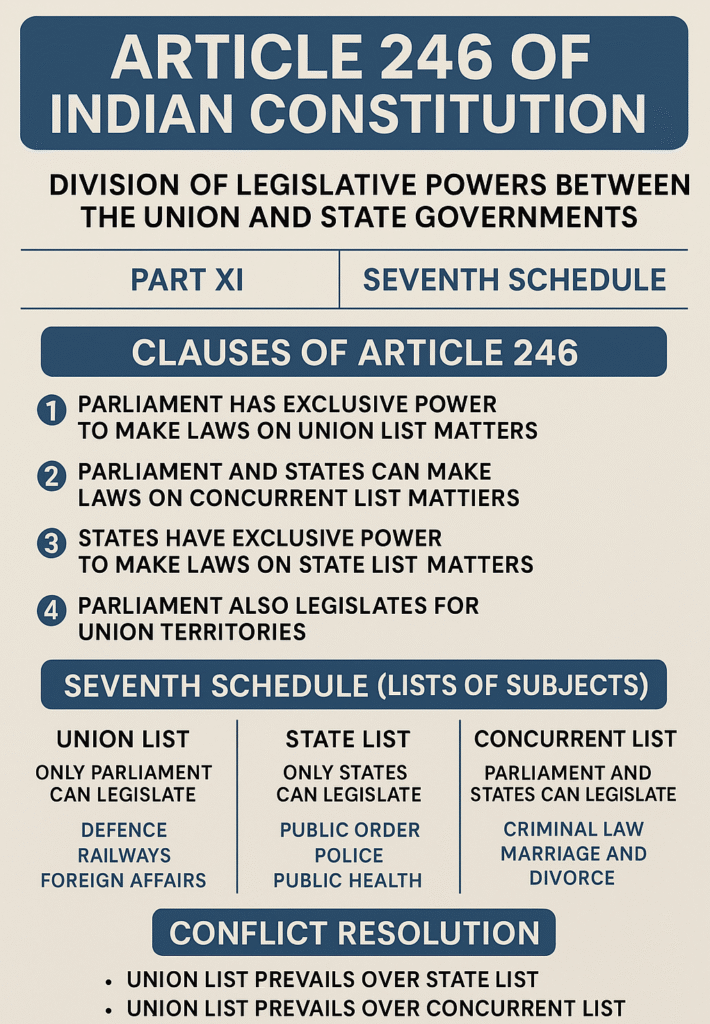Undoubtedly, one of the most critical components of India’s federal structure is Article 246 of the Indian Constitution. This article forms the foundation of legislative powers and how they are distributed between the Union and State Governments. As India follows a quasi-federal structure, understanding Article 246 is essential for anyone interested in governance, law, or public policy.
First of All, What Is Article 246 in the Indian Constitution?
Article 246 in the Indian Constitution deals directly with the division of legislative powers. It explicitly outlines which level of government can legislate on which subject.
- To begin with, Article 246 is housed under Part XI of the Constitution.
- Moreover, it operates through the Seventh Schedule, which classifies subjects into three lists:
- Union List
- State List
- Concurrent List
- Union List
- As a result, it clearly defines which body has jurisdiction over which subjects and in what circumstances.
Let’s Now Break Down Article 246 Clause by Clause
Each clause of Article 246 in Indian Constitution offers a different dimension of legislative authority.
1. Article 246(1) – Exclusive Power of Parliament
- First and foremost, it gives Parliament exclusive power to make laws on matters listed in the Union List.
- Therefore, even if a subject overlaps with a state interest, the central law will take precedence.
2. Article 246(2) – Concurrent Powers
- Furthermore, both Parliament and State Legislatures can make laws on matters listed in the Concurrent List.
- However, in case of a conflict, Parliament’s law will prevail unless the state law has received Presidential assent.
3. Article 246(3) – Exclusive Power of State Legislatures
- Subject to the above two, State Legislatures have exclusive power over matters listed in the State List.
- Hence, state governments can legislate independently on local issues like police, agriculture, and public health.
4. Article 246(4) – Union Power Over Territories Not Part of Any State
- Importantly, Parliament also has the power to legislate for Union Territories or acquired territories, even on subjects from the State List.
What Is the Seventh Schedule All About?
The Seventh Schedule under Article 246 in the Indian Constitution provides the actual classification of subjects. It is the practical roadmap for implementing federalism in India.
● Union List (List I)
- This includes 100 subjects of national importance.
- Subjects include:
- Defence
- Atomic Energy
- Railways
- Foreign Affairs
- Currency and Banking
- Defence
- Only Parliament has the power to legislate on these subjects.
● State List (List II)
- At the same time, this list contains 61 subjects of regional and local importance.
- Subjects include:
- Public Order
- Police
- Agriculture
- Local Government
- Public Health
- Public Order
- States have exclusive authority here, except in extraordinary situations.
● Concurrent List (List III)
- In contrast, this list allows both the Union and the State Governments to legislate.
- It includes 47 subjects like:
- Criminal Law
- Marriage and Divorce
- Forests
- Education
- Labour Welfare
- Criminal Law
- Nevertheless, if both make laws on the same subject, Union law overrides the state law.
Historical Evolution of Article 246 and the Seventh Schedule
The evolution of Article 246 in the Indian Constitution reflects India’s shifting federal balance.
● Originally:
- Union List had 97 subjects, now it has 100.
- State List had 66, now reduced to 61.
- Concurrent List had 47, now increased to 52.
● Through the 42nd Amendment Act (1976):
- Five subjects were moved from the State List to the Concurrent List:
- Education
- Forests
- Weights and Measures
- Protection of Wild Animals and Birds
- Administration of Justice (excluding SC/HC)
- Education
● Through the 101st Amendment Act (2016):
- Special provisions have been added for the Goods and Services Tax (GST).
- Parliament and the States both can legislate on GST.
- However, inter-state GST laws fall under Parliament’s exclusive domain.
Let’s Now Understand the Concept of Residuary Powers
- Additionally, subjects not listed in any of the three lists fall under residuary powers.
- These powers are exclusively held by Parliament.
- For instance, cyber laws and space technologies are considered residuary subjects.
But What Happens When There Is a Conflict?
The Constitution has built-in mechanisms to resolve such disputes under Article 246.
- If the Union List conflicts with the State List, the Union List prevails.
- If the Union List overlaps with the Concurrent List, the Union List still prevails.
- If the State List overlaps with the Concurrent List, then the Concurrent List prevails.
- However, if a state law on a Concurrent List subject has Presidential assent, it prevails in that state unless overridden by Parliament.
Comparative Federalism: How Does Article 246 Stand Globally?
- Unlike the U.S., where residuary powers rest with the states, India follows the Canadian model.
- Canada also provides residuary powers to the central government.
- In Australia, only one list exists for federal subjects.
- India’s three-list structure was first introduced by the Government of India Act, 1935, and was retained in the Constitution with federal supremacy clearly defined.
Important Commissions and Recommendations
Several bodies have examined Article 246 and the Seventh Schedule:
● Sarkaria Commission (1983):
- Supported the current structure.
- Recommended consultation with states before legislating on Concurrent List items.
● National Commission to Review the Working of the Constitution (2002):
- Observed the absence of a formal consultative mechanism for concurrent legislation.
● Rajamannar Committee (1971):
- Suggested a High-Powered Commission to redistribute entries in Union and Concurrent Lists.
Do We Need to Revisit Article 246 and the Seventh Schedule?
Over the years, many experts have called for re-examining the Seventh Schedule, primarily due to increasing centralization.
- Several amendments have shifted powers toward the Union.
- The labour market is one such domain that may benefit from greater state autonomy.
- Diverse development levels across states call for customized laws, not one-size-fits-all.
- Most importantly, India needs more decentralization, not less.
Conclusion
To conclude, Article 246 in Indian Constitution provides the framework for dividing legislative powers between the Union and States. It promotes federalism while also ensuring national unity through legislative supremacy in critical areas. However, with evolving socio-economic conditions, there is a growing need to revisit and refine this structure. Balancing central authority with state flexibility is crucial for a more efficient, responsive, and inclusive governance model.
Frequently Asked Questions (FAQs) on Article 246 in Indian Constitution
Article 246 defines the distribution of legislative powers between the Union and State Governments through three lists in the Seventh Schedule.
Union List is for Parliament, State List is for state legislatures, and the Concurrent List allows both to legislate, with Union law taking precedence.
Yes, under specific conditions like national emergencies or Rajya Sabha resolutions, Parliament can legislate on State List subjects.
The Central law prevails unless the State law has Presidential assent, which still allows Parliament to override it later.
Because increasing centralization has reduced state autonomy, experts recommend a re-evaluation to ensure balanced federalism.
CITATIONS
- The Seventh Schedule of the Indian Constitution: Analyzing the Division of Powers Between the Union and States
- Article 246
Prelims Practice Question (MCQ)
Q. Consider the following statements regarding Article 246 of the Indian Constitution:
- Article 246 provides the basis for the three-fold distribution of legislative powers between the Union and the States.
- The Concurrent List is exclusively under the jurisdiction of Parliament.
- In case of conflict between laws made by Parliament and State Legislatures on Concurrent List subjects, the Central law prevails.
- Parliament can make laws on State List matters during a national emergency.
Which of the statements given above are correct?
A. 1, 2, and 3
B. 1, 3, and 4
C. 2 and 4 only
D. 1, 2, and 4
Mains Practice Question (GS Paper 2)
Q. Article 246 of the Indian Constitution establishes the legislative framework of Indian federalism through the Seventh Schedule. Critically examine the significance and limitations of this structure in the context of growing centralization and state demands for autonomy.
(Word Limit: 250)










